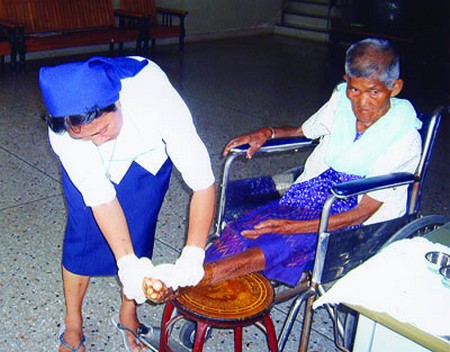It is essential for dressings to remain in place, so they must be carefully secured. The way to secure a particular dressing depends on what type it is.
Adhesive dressings
These are small pads of gauze with a waterproof adhesive backing, which is often perforated to let moisture evaporate. They are supplied in paper or plastic containers.
Adhesive plasters
Strips of adhesive plaster can be cut from a roll to secure small dressings. Waterproof plasters are especially useful for areas such as the hands.
Stretch plasters
These are used to cover quite large dressings. They also give some measure of support.
Clear adhesive tapes
These are used in cases of allergy or in areas where the skin is sensitive and might react to plaster, for instance around the eyes.
Plastic skin
This can be sprayed on to a wound from an aerosol can. Many patients discharged from hospital have this type of dressing, which gradually flakes off.
Tubular gauze
Especially useful for fingers and hands, tubular gauze makes a neat, firm bandage. It is supplied as a seamless roll, and is available in various widths to fit different parts of the body. It is applied with a special applicator. Apart from the finger size, tubular gauze is not practical for use in the home: it is expensive and a different applicator is needed for each part of the body. If thought advisable for a patient at home, the community nursing sister will supply you with the appropriate applicator and full instructions.
Elasticized net bandages
Made of two-way stretch tubular mesh, these bandages are easy to apply and comfortable to wear. They are especially valuable for securing dressings to difficult places such as the head, shoulder, thigh and groin. The bandages can be cut to the required length and stretched over the dressing, and because they do not fray, holes can be cut where necessary to form a sleeve or a trouser leg. You need the correct width of bandage and a little practice to make sure of a good fit.
Roller bandages
At one time, these were used extensively to secure dressings, because they provided support while restricting movement. Nowadays different methods are used, and roller bandages are applied less frequently. However, it is still useful to know how to apply one.
Roller bandages are strips of material: they can be cotton, crepe, flannel, calico or special paper. They are five to six metres in length and their width varies depending on the part to be bandaged and the age and size of the patient. You will need:
- a width of 2.5cm to bandage a finger
- 5cm for a hand
- 5cm for a head
- 5-6cm for an arm
- 7.5-9cm for a leg
- 10-15cm for a trunk.
